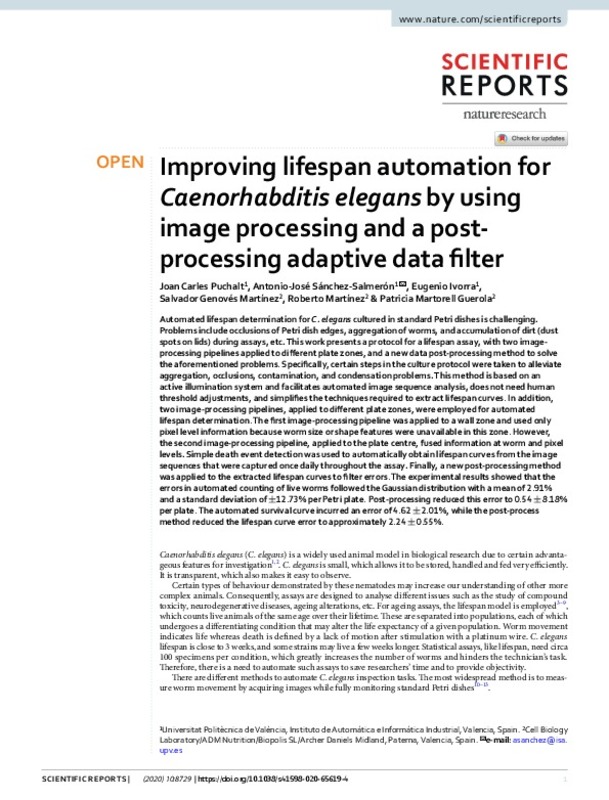Brenner, S. The Genetics Of Caenorhabditis Elegans. Genetics 77, 71–94 (1974).
Tissenbaum, H. A. & Using, C. Elegans for aging research. Invertebr. Reproduction & Dev. 59, 59–63, https://doi.org/10.1080/07924259.2014.940470 (2015).
Amrit, F. R. G., Ratnappan, R., Keith, S. A. & Ghazi, A. The C. elegans lifespan assay toolkit. Methods 68, 465–475, https://doi.org/10.1016/j.ymeth.2014.04.002 (2014).
[+]
Brenner, S. The Genetics Of Caenorhabditis Elegans. Genetics 77, 71–94 (1974).
Tissenbaum, H. A. & Using, C. Elegans for aging research. Invertebr. Reproduction & Dev. 59, 59–63, https://doi.org/10.1080/07924259.2014.940470 (2015).
Amrit, F. R. G., Ratnappan, R., Keith, S. A. & Ghazi, A. The C. elegans lifespan assay toolkit. Methods 68, 465–475, https://doi.org/10.1016/j.ymeth.2014.04.002 (2014).
Guarente, L. & Kenyon, C. Genetic pathways that regulate ageing in model organisms. Nature 408, 255 (2000).
Hosono, R. Age dependent changes in the behavior of Caenorhabditis elegans on attraction to Escherichia coli. Exp. Gerontol. 13, 31–36, https://doi.org/10.1016/0531-5565(78)90027-X (1978).
Hosono, R. Sterilization and growth inhibition of Caenorhabditis elegans by 5-fluorodeoxyuridine. Exp. Gerontol. 13, 369–373, https://doi.org/10.1016/0531-5565(78)90047-5 (1978).
Kenyon, C. J. The genetics of ageing. Nature 464, 504 (2010).
Klass, M. R. Aging in the nematode Caenorhabditis elegans: Major biological and environmental factors influencing life span. Mech. Ageing Dev. 6, 413–429, https://doi.org/10.1016/0047-6374(77)90043-4 (1977).
Walker, D. W., McColl, G., Jenkins, N. L., Harris, J. & Lithgow, G. J. Evolution of lifespan in C. elegans. Nature 405, 296–297, https://doi.org/10.1038/35012693 (2000).
Hertweck, M. & Baumeister, R. Automated assays to study longevity in C. elegans. In Mechanisms of Ageing and Development 126, 139–145, https://doi.org/10.1016/j.mad.2004.09.010 (2005).
Puckering, T. et al. Automated Wormscan. F1000Research 6, 192, https://doi.org/10.12688/f1000research.10767.2 (2017).
Stroustrup, N. et al. The Caenorhabditis elegans Lifespan Machine. Nat. methods 10, 665–70, https://doi.org/10.1038/nmeth.2475 NIHMS150003 (2013).
Swierczek, N. A., Giles, A. C., Rankin, C. H. & Kerr, R. A. High-throughput behavioral analysis in C. elegans. Nat. Methods 8, 592–U112, https://doi.org/10.1038/nmeth.1625 (2011).
Puchalt, J. C., Sánchez-Salmerón, A.-J., Martorell Guerola, P. & Genovés Martínez, S. Active backlight for automating visual monitoring: An analysis of a lighting control technique for Caenorhabditis elegans cultured on standard Petri plates. Plos One 14, e0215548 (2019).
Chen, W. et al. Segmenting Microscopy Images of Multi-Well Plates Based on Image Contrast. Microsc. Microanal. 23, 932–937, https://doi.org/10.1017/S1431927617012375 (2017).
Cronin, C. J. et al. An automated system for measuring parameters of nematode sinusoidal movement. BMC GENETICS 6, https://doi.org/10.1186/1471-2156-6-5 (2005).
Fontaine, E., Burdick, J. & Barr, A. Automated Tracking of Multiple C. Elegans. In 2006 International Conference of the IEEE Engineering in Medicine and Biology Society, 3716–3719, https://doi.org/10.1109/IEMBS.2006.260657 (2006).
Geng, W., Cosman, P., Baek, J.-H., Berry, C. C. & Schafer, W. R. Quantitative Classification and Natural Clustering of Caenorhabditis elegans Behavioral Phenotypes. Genetics 165, 1117 LP–1126 (2003).
Geng, W., Cosman, P., Berry, C. C., Feng, Z. & Schafer, W. R. Automatic tracking, feature extraction and classification of C. elegans phenotypes. IEEE Transactions on Biomed. Eng. 51, 1811–1820, https://doi.org/10.1109/TBME.2004.831532 (2004).
Jung, S. K., Aleman-Meza, B., Riepe, C. & Zhong,W. QuantWorm: A comprehensive software package for Caenorhabditis elegans phenotypic assays. Plos One 9, https://doi.org/10.1371/journal.pone.0084830 (2014).
Kainmueller, D., Jug, F., Rother, C. & Myers, G. Active Graph Matching for Automatic Joint Segmentation and Annotation of C. elegans BT - Medical Image Computing and Computer-Assisted Intervention – MICCAI 2014. 81–88 (Springer International Publishing, Cham, 2014).
Mathew, M. D., Mathew, N. D. & Ebert, P. R. WormScan: A Technique for High-Throughput Phenotypic Analysis of Caenorhabditis elegans. Plos One 7, https://doi.org/10.1371/journal.pone.0033483 (2012).
Raviv, T. R. et al. Morphology-Guided Graph Search for Untangling Objects: C. elegans Analysis BT - Medical Image Computing and Computer-Assisted Intervention – MICCAI 2010. 634–641 (Springer Berlin Heidelberg, Berlin, Heidelberg, 2010).
Restif, C. et al. CeleST: Computer Vision Software for Quantitative Analysis of C. elegans Swim Behavior Reveals Novel Features of Locomotion. Plos Comput. Biol. 10, https://doi.org/10.1371/journal.pcbi.1003702 (2014).
Roussel, N., Morton, C. A., Finger, F. P. & Roysam, B. A Computational Model for C. elegans Locomotory Behavior: Application to Multiworm Tracking. IEEE Transactions on Biomed. Eng. 54, 1786–1797, https://doi.org/10.1109/TBME.2007. 894981 (2007).
Tsechpenakis, G., Bianchi, L., Metaxas, D. N. & Driscoll, M. A novel computational approach for simultaneous tracking and feature extraction of C. elegans populations in fluid environments. IEEE Transactions on Biomed. Eng. 55, 1539–1549, https://doi.org/10.1109/TBME.2008.918582 (2008).
Wählby, C. et al. An image analysis toolbox for high-throughput C. elegans assays. Nat. methods 9, 714–6, https://doi.org/10.1038/nmeth.1984 (2012).
Churgin, M. A. et al. Longitudinal imaging of Caenorhabditis elegans in a microfabricated device reveals variation in behavioral decline during aging. eLife 6, https://doi.org/10.7554/eLife.26652 (2017).
Aitlhadj, L. & Stürzenbaum, S. R. The use of FUdR can cause prolonged longevity in mutant nematodes. Mech. Ageing Dev. 131, 364–365, https://doi.org/10.1016/j.mad.2010.03.002 (2010).
Stiernagle, T. Maintenance of C. elegans, https://doi.org/10.1895/wormbook.1.101.1 (2006).
McGrath, P. T. et al. Quantitative Mapping of a Digenic Behavioral Trait Implicates Globin Variation in C. elegans Sensory Behaviors. Neuron 61, 692–699, https://doi.org/10.1016/j.neuron.2009.02.012 (2009).
Sterken, M. G., Snoek, L. B., Kammenga, J. E. & Andersen, E. C. The laboratory domestication of Caenorhabditis elegans. Trends genetics: TIG 31, 224–231, https://doi.org/10.1016/j.tig.2015.02.009 (2015).
Kenyon, C., Chang, J., Gensch, E., Rudner, A. & Tabtiang, R. A C. elegans mutant that lives twice as long as wild type. Nature 366, 461–464, https://doi.org/10.1038/366461a0 (1993).
Dorman, J. B., Albinder, B., Shroyer, T. & Kenyon, C. The age-1 and daf-2 genes function in a common pathway to control the lifespan of Caenorhabditis elegans. Genetics 141, 1399–1406 (1995).
[-]









